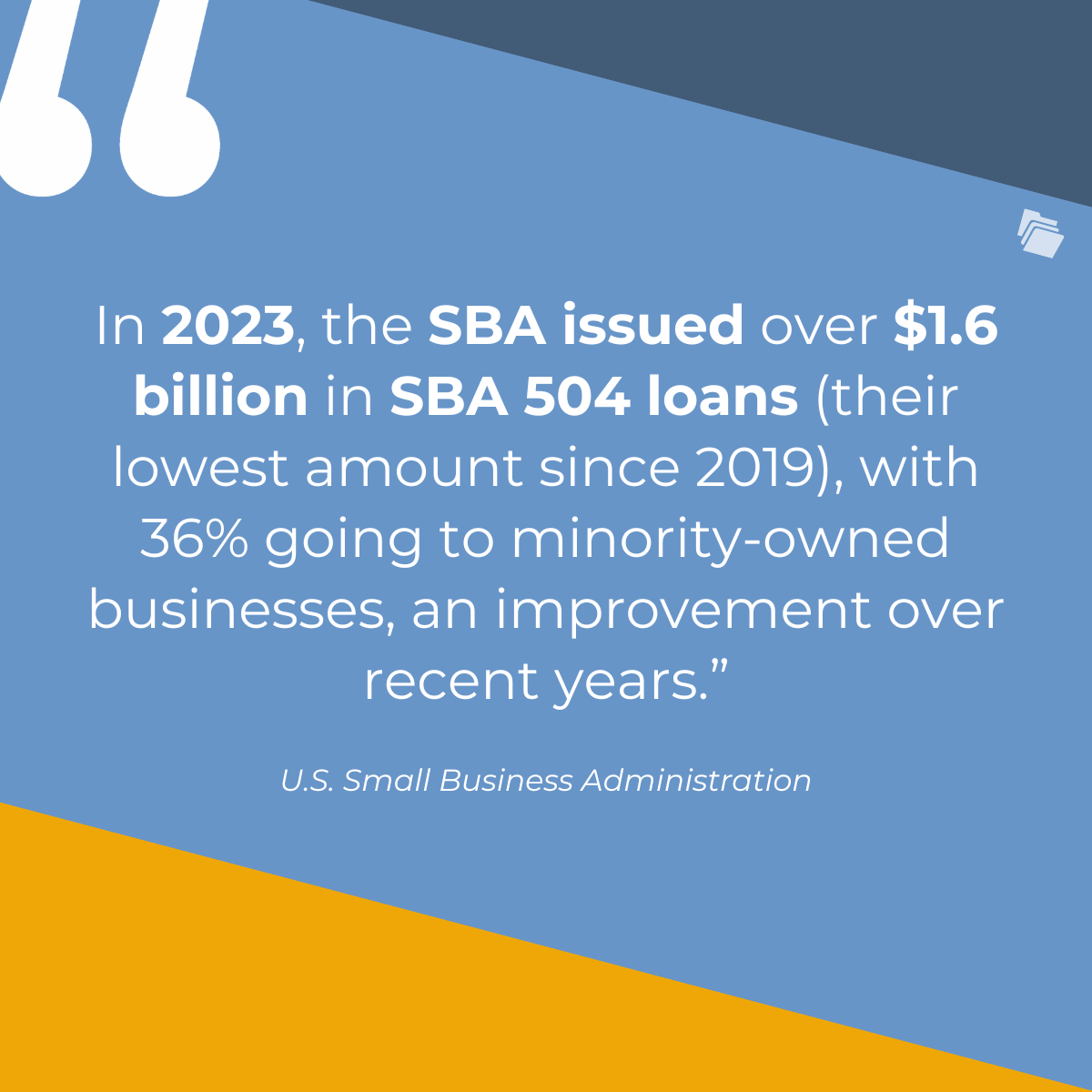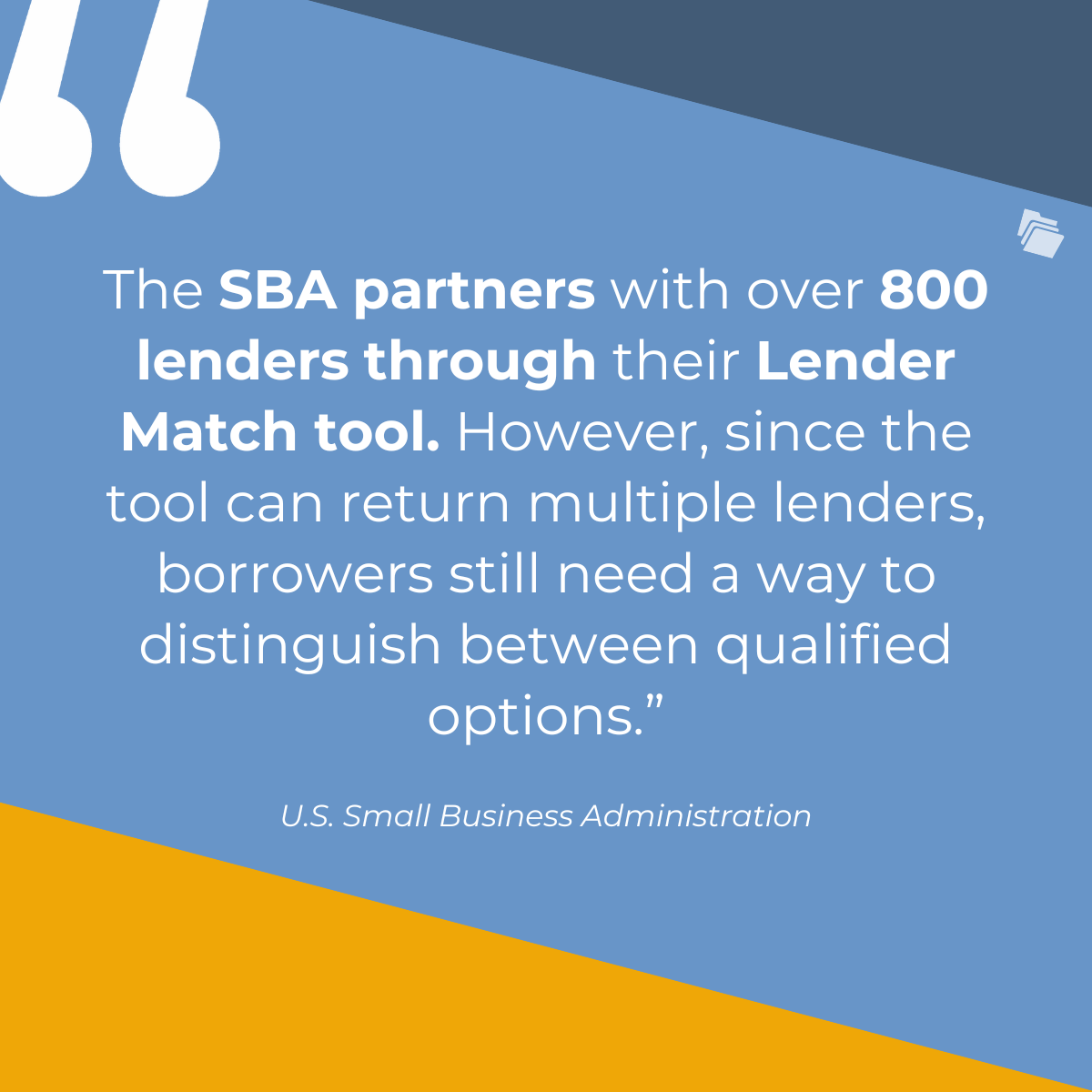The Small Business Administration (SBA) 504 loan program provides small businesses with funding to purchase or improve long-term fixed assets like real estate, machinery, and equipment. What sets 504 loans apart from other financial products—aside from their intended uses—is that they have three parties: a borrower, a lender (usually a bank or credit union), and a Certified Development Company (CDC).
While the CDC contributes 40% of the capital for the loan, the biggest portion—50%—comes from the lender. The SBA sets many of the standard terms for SBA 504 loans, but other terms are negotiated between the borrower and lender. In other words, choosing the right lender is instrumental to your SBA 504 loan.
In 2023, the SBA issued over $1.6 billion in SBA 504 loans (their lowest amount since 2019), with 36% going to minority-owned businesses, an improvement over recent years. In 2024, the SBA is targeting an additional $1.5 billion in lending. This guide will tell you everything you need to select the right lender to get in on this funding opportunity.

Understanding the SBA 504 Loan Program
SBA 504 loans are unique from other financial products because of their bespoke structure. Instead of coming up with the entire capital for the loan themselves, financial institutions only provide 50% of the funding. The remaining 40% comes from CDCs and a 10% downpayment from the borrower.
The funds from SBA 504 loans are intended to be used for purchasing or improving long-term fixed assets within the organization—from repairing machinery to building parking lots. However, the funds cannot be used as working capital, for speculative investments, or to pay for non-asset business expenditures like payroll or rent expenses.
Finding The Right Lender
Your lender, together with the CDC, will guide you through your loan application process and negotiate terms. They contribute the majority of the capital for the loan and perform most of the servicing functions for the loan, so choosing the right lender can make all the difference.
SBA’s Lender Match Tool Can Help You Select a Qualified Lender
The Small Business Administration approves third-party financial institutions to act as lenders for SBA loans based on their geographical location, finances, and character. To get connected with an SBA-approved lender, borrowers can use the SBA’s lender match tool.
First, borrowers will describe their business needs and provide details about their organization. The SBA takes that information and distributes it to qualified lenders who will contact the borrower to negotiate terms and request further information. From there, the lender and CDC guide borrowers through the application process.
The SBA uses multiple factors in qualifying third-party lenders, such as the history, good standing, and character of an institution along with their financial position and geographical location. The SBA’s qualified list includes local and community banks, as well as non-bank lenders such as credit unions. Together, these financial institutions have the integrity, liquidity, and positioning to partner with the SBA to issue 504 loans.
How to Choose the Right Lender
While the SBA’s lender match tool gives borrowers an easy way to speed up their lender search, borrowers must still narrow down the list of qualified lenders for themselves. Here are some guidelines for navigating the lender selection stage of applying for an SBA 504 loan.
What Makes a Lender Unique?
Each SBA-qualified lender shares some commonalities: they’re generally reputable, financially sound, and participate in the SBA’s 504 loan program. The SBA partners with over 800 lenders through their Lender Match tool. However, since the tool can return multiple lenders, borrowers still need a way to distinguish between qualified options.

Here are some factors that can make lenders distinct from each other:
- Loan Terms. While some of the terms of SBA 504 loans are set in stone by the SBA, other terms are negotiable between the borrower and the lender. Terms such as early repayment penalties and the length of the loan can differ from lender to lender, so pay close attention to loan terms when selecting a financial institution.
- Fees and Closing Costs. SBA 504 loan interest rates are locked to an increment above a 10-year U.S. Treasury bond, so each lender will have the same interest rate. However, the same cannot be said about closing costs and fees. Each lender sets their own fees and closing costs, so this variable should be a high consideration as you narrow down your selection.
- Geographical Location. In the internet age, geographical location has been deprioritized in many industries. However, when it comes to investing in local small businesses, you want a lender who serves your geographical area. This makes it easier to get your questions answered, to make in-person payments, and to work collaboratively with a financial institution that understands your area.
- Customer Service. While the CDC helps with some aspects of the application process, the lender performs most of the loan servicing functions for SBA 504 loans. They are the primary point of contact for most questions, and the primary bottleneck for paperwork. When selecting a lender, pay close attention to their reputation, knowledgeability, and personalized service as this can be a major factor in how long your application process takes—and how much of a headache it can be.
Understanding Fixed vs. Variable Interest Rates
Variable interest rates offer a unique risk for borrowers as changes to the lender’s index can increase their interest rates and monthly payments. Of course, their interest rate may also go down, but variable-rate loans typically have a relatively high floor, making the risk of an increasing rate greater than the chance of a decreasing rate.
Fixed-rate loans carry an altogether different type of risk—timing risk. In a fixed-rate loan, such as an SBA 504 loan, the rate stays the same throughout the life of the loan, meaning borrowers are “locked in” to the rate they locked during closing. If the market changes and the U.S. Treasury index (the index used in determining the rate for SBA 504 loans) goes down, borrowers will still be locked into the higher rate unless they refinance the loan.
SBA 504 loans are pegged to an increment above the rate for a 10-year U.S. Treasury bond, a generally favorable rate for borrowers. However, since the loan is a fixed-rate over 10-, 20-, or 25-year repayment terms, borrowers should be mindful of the timing of their loan—and avoid locking their rate when U.S. Treasury bonds are peaking.
Next Steps in the Application Process
Once you’ve selected the best lender (based on loan terms, fees, closing costs, location, and customer service) and understand the timing risk of a fixed-rate loan, it’s time to take the next steps toward submitting your final application.
Together, the lender and CDC will guide you through the application process, which involves gathering a large amount of paperwork including up-to-date financial statements, multiple years of previous tax returns, and other ad-hoc documentation. This stage of the application process can be a major bottleneck and can result in significant delays due to the sheer volume of documentation.
However FileInvite can dramatically decrease loan document turnaround times and improve the borrower and lender experience.
Streamline SBA 504 Loan Processing with FileInvite
FileInvite simplifies and streamlines the document collection process. We already work with dozens of CDCs and qualified lenders to significantly speed up the SBA loan application process. By automating the document collection process, FileInvite reduces the administrative workload involved in manually collecting, tracking, and storing documents. It enables lenders to send automated requests for documents and receive real-time updates when documents are submitted by applicants, ensuring no delays in the application process.
Importantly, FileInvite enhances compliance through its secure portal, which is designed to handle sensitive financial documents, providing both encryption and access control. This is crucial for maintaining the security of the applicant's personal and business information. By integrating with existing lender systems and offering a single portal for document management, FileInvite minimizes the potential for errors and omissions, leading to a more efficient approval process.
To learn more and request a demo, visit FileInvite today.

Related Posts: